Each year Golf Digest honors the highest scoring new or remodeled courses in four categories: Best New Public Course, Best New Private Course, Best Renovation (courses that undergo conventional improvements like tree removal, new bunkers, altered tees and expanded or relocated greens) and Best Transformation (courses that are fundamentally remodeled with new or rerouted holes).
Nationally, we had the most course openings since 2010, and an increasing number of courses are undergoing major renovations. Golf Digest panelists visited 55 candidate courses for the 2023 awards (30 Best Renovation candidates and 25 Best New/Best Transformation). Both the quality and quantity of courses are up as the 2023 honorees are an extraordinary lot.
BEST NEW PRIVATE COURSE
Ladera Golf Club, Thermal, Calif.7,705 yards, par 72Gil Hanse and Jim Wagner
 Ladera Golf Club Thermal, CA Ladera breaks the mold of desert golf in Palm Springs and the Coachella Valley. The design does not incorporate unnatural water features, it’s not lined by palm trees, and it’s not constrained by housing considerations. Instead, it is a beautiful and varied expression of what desert golf can be in its most natural form, though nothing about it is natural. The 300-acre site slopes 140 feet from the high point near the Santa Rosa Mountains across once-level land that was formerly lemon groves and mango farms. Hanse and Wagner propped up the low side of the property to reorient sightlines over the valley floor toward the eastern Mecca Hills and moved millions of cubic yards of earth to create each particle of golf.Ladera’s fairways are generous, 60 to 100 yards with no formal rough, but strategy abounds with options to play to wide parts of the fairway though the best approach angles and lines-of-sight are reserved for those who skirt the boundaries of the hazards. Even completely straight holes, such as the par-5 seventh, are full of options with staggered bunkers and a treacherous side slope short of the green. The greens reveal a tremendous variety of sizes and forms, some modestly contoured like the enormous saucer third and others a pattern of ridges and falling tiers (the 14th). But the most distinctive features at Ladera are the attractive dry gullies and arroyos that Hanse, Wagner and their team cut through the site emulating sandy, eroded vegetative lows that water would rush through during rare periods of heavy rain. The excavated sand was used to create sweeping elevation changes and to prop up greens like the par-3 fourth, the altar-like 15th, the par-3 16th and the par-5 17th that hangs over the edge of a deep arroyo. Explore our full review More from Golf Digest
Ladera Golf Club Thermal, CA Ladera breaks the mold of desert golf in Palm Springs and the Coachella Valley. The design does not incorporate unnatural water features, it’s not lined by palm trees, and it’s not constrained by housing considerations. Instead, it is a beautiful and varied expression of what desert golf can be in its most natural form, though nothing about it is natural. The 300-acre site slopes 140 feet from the high point near the Santa Rosa Mountains across once-level land that was formerly lemon groves and mango farms. Hanse and Wagner propped up the low side of the property to reorient sightlines over the valley floor toward the eastern Mecca Hills and moved millions of cubic yards of earth to create each particle of golf.Ladera’s fairways are generous, 60 to 100 yards with no formal rough, but strategy abounds with options to play to wide parts of the fairway though the best approach angles and lines-of-sight are reserved for those who skirt the boundaries of the hazards. Even completely straight holes, such as the par-5 seventh, are full of options with staggered bunkers and a treacherous side slope short of the green. The greens reveal a tremendous variety of sizes and forms, some modestly contoured like the enormous saucer third and others a pattern of ridges and falling tiers (the 14th). But the most distinctive features at Ladera are the attractive dry gullies and arroyos that Hanse, Wagner and their team cut through the site emulating sandy, eroded vegetative lows that water would rush through during rare periods of heavy rain. The excavated sand was used to create sweeping elevation changes and to prop up greens like the par-3 fourth, the altar-like 15th, the par-3 16th and the par-5 17th that hangs over the edge of a deep arroyo. Explore our full review More from Golf Digest  Best New Gil Hanse’s Ladera Golf Club is an ultra-exclusive desert oasis outside Palm Springs. We got a first look
Best New Gil Hanse’s Ladera Golf Club is an ultra-exclusive desert oasis outside Palm Springs. We got a first look
RUNNERS-UP:
(1) Lost Rail G.C., Gretna, Neb. (below) Scott Hoffman and Landscapes Unlimited
%20--%20Photo%20No.%205.jpg.rend.hgtvcom.406.325.suffix/1704296299078.jpeg) Private Lost Rail Golf Club Gretna, NE Building Lost Rail, just southwest of Omaha, was something of a homecoming for Scottsdale-based architect Scott Hoffman, who grew up in the city and went to school at Creighton. The key to the design, named after an abandoned trainline that ran through the northeast corner of the property, was decoding the routing for this relatively small parcel of land, around 150 acres, or just large enough for 18 holes, a practice facility, clubhouse, parking and maintenance. The matter was complicated by the deep, wooded ravines that cut through the site and further limited the areas where holes could be placed. It was an exercise perfectly suited to Hoffman’s skills, who specialized in laying out the holes on numerous Tom Fazio projects across the western U.S. throughout the early 2000s. The ravines serve as both strategic and penal hazards, flanking and bisecting holes and creating dramatic, intimidating scenery. View Course
Private Lost Rail Golf Club Gretna, NE Building Lost Rail, just southwest of Omaha, was something of a homecoming for Scottsdale-based architect Scott Hoffman, who grew up in the city and went to school at Creighton. The key to the design, named after an abandoned trainline that ran through the northeast corner of the property, was decoding the routing for this relatively small parcel of land, around 150 acres, or just large enough for 18 holes, a practice facility, clubhouse, parking and maintenance. The matter was complicated by the deep, wooded ravines that cut through the site and further limited the areas where holes could be placed. It was an exercise perfectly suited to Hoffman’s skills, who specialized in laying out the holes on numerous Tom Fazio projects across the western U.S. throughout the early 2000s. The ravines serve as both strategic and penal hazards, flanking and bisecting holes and creating dramatic, intimidating scenery. View Course
(2) Wicker Point G.C., Alexander City, Ala. Bill Coore and Ben Crenshaw
.jpg.rend.hgtvcom.406.305.suffix/1704312078834.jpeg) Wicker Point Golf Club Alexander City, AL The sister course to nearby Willow Point and operated by developer Russell Lands, Wicker Point rides up and down the forested hills of Lake Martin in east-central Alabama, climbing into the highlands before dipping down to the water where five different greens kiss the shore. Architects Bill Coore and Ben Crenshaw used the sometimes abrupt topography to create strategic slide slopes, speed slots and the occasional hit-and-hope blind shot to keep players alert and thinking. When Wicker Point’s show-stopping cross-cove par 3s at 12 and 17 were being constructed, Coore and Crenshaw were simultaneously building stunning seaside par 3 holes at Te Arai in New Zealand (the 17th hole at the South Course) and along the rocky Atlantic bluffs at Cabot Saint Lucia (particularly the 16th and 17th). Coore joked to his respective shapers of each hole that it was going to be a competition to see which turned out the best. Most golfers will agree there are no losers in this scenario. View Course BEST NEW PUBLIC COURSE
Wicker Point Golf Club Alexander City, AL The sister course to nearby Willow Point and operated by developer Russell Lands, Wicker Point rides up and down the forested hills of Lake Martin in east-central Alabama, climbing into the highlands before dipping down to the water where five different greens kiss the shore. Architects Bill Coore and Ben Crenshaw used the sometimes abrupt topography to create strategic slide slopes, speed slots and the occasional hit-and-hope blind shot to keep players alert and thinking. When Wicker Point’s show-stopping cross-cove par 3s at 12 and 17 were being constructed, Coore and Crenshaw were simultaneously building stunning seaside par 3 holes at Te Arai in New Zealand (the 17th hole at the South Course) and along the rocky Atlantic bluffs at Cabot Saint Lucia (particularly the 16th and 17th). Coore joked to his respective shapers of each hole that it was going to be a competition to see which turned out the best. Most golfers will agree there are no losers in this scenario. View Course BEST NEW PUBLIC COURSE
The Lido at Sand Valley, Nekoosa, Wis. 7,027 yards, par 72C.B. Macdonald/Tom Doak
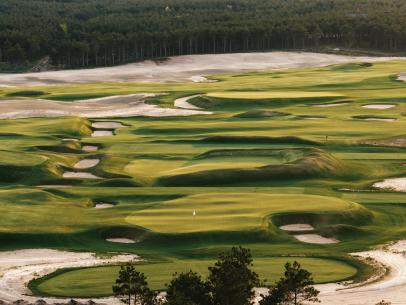 Public Sand Valley: The Lido Nekoosa, WI The Lido at Sand Valley in central Wisconsin opened in May, 2023, and is a down-to-the-inch recreation of The Lido that C.B. Macdonald built on Long Island from 1914 to 1917. Heralded as one of the country’s greatest courses, it went extinct in the 1940s when the U.S. government converted the land to a naval base.Rebuilding The Lido has been the fantasy of many historians, but doing so accurately became possible when Peter Flory, a financial consultant and architecture enthusiast, developed a detailed computer simulation of the course based on scrupulous study of old photographs and other material. Sand Valley proprietors Michael and Chris Keiser discovered Flory’s computer model, then asked architect Tom Doak if he could use it to rebuild the course.First the animated contours had to be translated into a physical GPS topographical blueprint, a technological hack accomplished by digital mapping specialist Brian Zager. The GPS map enabled Doak and his associates to reconstruct Lido holes like Plateau, Alps, Cape and Long in exquisite detail, along with originals like the Dog’s Leg sixth and the Home 18th, making only minor adjustments for drainage and adding longer tees for modern play. Though there’s no Atlantic Ocean crashing near the Biarritz eighth green or stiff coastal winds swatting around balls, the ”new” Lido is a stunning representation of Macdonald’s groundbreaking accomplishment and a vivid throwback to a more daring era of architecture. Using the spacious hole corridors to explore different routes into the giant greens is half the fun. Contemplating players navigating holes like the Channel fourth, with an alternative island fairway for daring hitters and a green perched behind a high rampart bunker, using hickory shafts and Haskell balls, is the other half. View Course
Public Sand Valley: The Lido Nekoosa, WI The Lido at Sand Valley in central Wisconsin opened in May, 2023, and is a down-to-the-inch recreation of The Lido that C.B. Macdonald built on Long Island from 1914 to 1917. Heralded as one of the country’s greatest courses, it went extinct in the 1940s when the U.S. government converted the land to a naval base.Rebuilding The Lido has been the fantasy of many historians, but doing so accurately became possible when Peter Flory, a financial consultant and architecture enthusiast, developed a detailed computer simulation of the course based on scrupulous study of old photographs and other material. Sand Valley proprietors Michael and Chris Keiser discovered Flory’s computer model, then asked architect Tom Doak if he could use it to rebuild the course.First the animated contours had to be translated into a physical GPS topographical blueprint, a technological hack accomplished by digital mapping specialist Brian Zager. The GPS map enabled Doak and his associates to reconstruct Lido holes like Plateau, Alps, Cape and Long in exquisite detail, along with originals like the Dog’s Leg sixth and the Home 18th, making only minor adjustments for drainage and adding longer tees for modern play. Though there’s no Atlantic Ocean crashing near the Biarritz eighth green or stiff coastal winds swatting around balls, the ”new” Lido is a stunning representation of Macdonald’s groundbreaking accomplishment and a vivid throwback to a more daring era of architecture. Using the spacious hole corridors to explore different routes into the giant greens is half the fun. Contemplating players navigating holes like the Channel fourth, with an alternative island fairway for daring hitters and a green perched behind a high rampart bunker, using hickory shafts and Haskell balls, is the other half. View Course
MORE: I got to play the new Lido course at Sand Valley. Here’s what makes it so unique
RUNNERS-UP:
(1) Black Desert Resort, Ivins, Utah. Tom Weiskopf and Phil Smith
 Public Black Desert Resort At Entrada Ivins, UT Black Desert Resort in the arid desert of southern Utah, surrounded by horizons of red rock mountains, was the last golf course Tom Weiskopf was involved in building (he was diagnosed with cancer as construction was beginning). Opened in 2023, the public course is a stunning juxtaposition of wavy fairways chiseled out of fields of black lava rock that had to be blasted into golf formations. Phil Smith, Weiskopf’s longtime design partner, completed the visually arresting design that will host the PGA Tour’s new Black Desert Championship in the fall of 2024, and another LPGA event the following year. Black Desert Resort is located outside the golf-rich area of St. George, Utah. The PGA Tour will host a new event at Black Desert in 2024, marking the first PGA Tour event in Utah in more than 60 years. View Course
Public Black Desert Resort At Entrada Ivins, UT Black Desert Resort in the arid desert of southern Utah, surrounded by horizons of red rock mountains, was the last golf course Tom Weiskopf was involved in building (he was diagnosed with cancer as construction was beginning). Opened in 2023, the public course is a stunning juxtaposition of wavy fairways chiseled out of fields of black lava rock that had to be blasted into golf formations. Phil Smith, Weiskopf’s longtime design partner, completed the visually arresting design that will host the PGA Tour’s new Black Desert Championship in the fall of 2024, and another LPGA event the following year. Black Desert Resort is located outside the golf-rich area of St. George, Utah. The PGA Tour will host a new event at Black Desert in 2024, marking the first PGA Tour event in Utah in more than 60 years. View Course
(2) PGA Frisco, Fields Ranch East, Texas. Gil Hanse and Jim Wagner
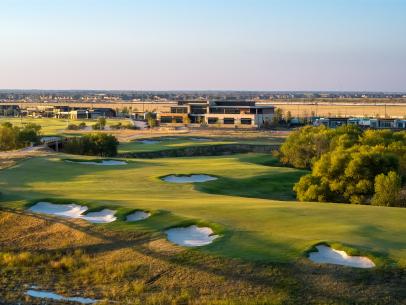 PGA Frisco: Fields Ranch East Frisco, TX The East Course at the Omni PGA Frisco is one of two courses to open at the new Fields Ranch Golf Club. Alongside the Beau Welling-designed West course is the East, built by Gil Hanse and Jim Wagner, which measures over 7,800 yards from the championship tees and puts a greater emphasis on driving than the West, demanding length, accuracy and the courage to take on cross-bunkers and central hazards. The greens, perched above bunkers and chipping runoffs, are smaller and require controlled approaches, and the holes of the second nine prowl the basin of Panther Creek. Though only in its first year (both courses opened in May), the East has already hosted the KitchenAid Senior PGA Championship. It is set to host a number of other prestigious events, including the PGA Championship (2027, 2034), the KPMG Women’s PGA Championship (2025, 2031) and the KitchenAid Senior PGA Championship again in 2029. View Course
PGA Frisco: Fields Ranch East Frisco, TX The East Course at the Omni PGA Frisco is one of two courses to open at the new Fields Ranch Golf Club. Alongside the Beau Welling-designed West course is the East, built by Gil Hanse and Jim Wagner, which measures over 7,800 yards from the championship tees and puts a greater emphasis on driving than the West, demanding length, accuracy and the courage to take on cross-bunkers and central hazards. The greens, perched above bunkers and chipping runoffs, are smaller and require controlled approaches, and the holes of the second nine prowl the basin of Panther Creek. Though only in its first year (both courses opened in May), the East has already hosted the KitchenAid Senior PGA Championship. It is set to host a number of other prestigious events, including the PGA Championship (2027, 2034), the KPMG Women’s PGA Championship (2025, 2031) and the KitchenAid Senior PGA Championship again in 2029. View Course
(3) PGA Frisco, Fields Ranch West, Texas. Beau Welling
 Fields Ranch PGA of America Frisco: West Course Frisco, TX Beau Welling, the lead architect for Tiger Woods’ design company, was instrumental in building Bluejack National, ranked third in the state. He returned to Texas with his own design of the West Course at the new PGA Frisco, headquarters of the PGA of America, a course designed to be a swashbuckling, playable alter-ego to the more tournament-oriented East Course. Welling accentuated the site’s gradual elevations to create a number of downhill drives to go along with large, roller coaster greens and fairways that stretch 50 to 90 yards across. As one of our course ranking panelists put it, “America definitely needs more courses like the West—fun to play, tough to lose balls, and good birdie opportunities with well executed shots.” View Course
Fields Ranch PGA of America Frisco: West Course Frisco, TX Beau Welling, the lead architect for Tiger Woods’ design company, was instrumental in building Bluejack National, ranked third in the state. He returned to Texas with his own design of the West Course at the new PGA Frisco, headquarters of the PGA of America, a course designed to be a swashbuckling, playable alter-ego to the more tournament-oriented East Course. Welling accentuated the site’s gradual elevations to create a number of downhill drives to go along with large, roller coaster greens and fairways that stretch 50 to 90 yards across. As one of our course ranking panelists put it, “America definitely needs more courses like the West—fun to play, tough to lose balls, and good birdie opportunities with well executed shots.” View Course
(4) The Park West Palm, West Palm Beach, Fla. Gil Hanse and Jim Wagner
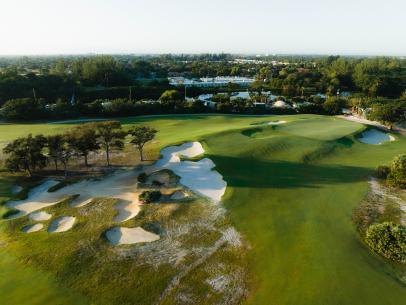 Public The Park at West Palm Beach West Palm Beach, FL In the current age of new elite private clubs and faraway destinatiion resorts, the opening of a public municipal-affiliated golf course in an urban area is major news—especially when Tiger Woods shows up for the grand opening, like he did in March 2023. The Park is the latest in a growing trend of public/private partnerships that have fueled the redevelopment of numerous municipal courses around the country. The new course is set on the site of the former Dick Wilson-designed West Palm Beach Golf Course, one of the first notable designs of the post-World War II years when it opened in 1947 and long considered among the top municipal courses in the country. That course closed in 2018 due to deteriorating playability and diminished interest and sat fallow for several years. Several plans for different uses of the land were proposed before a group of local citizens, led in part by Seth Waugh, CEO of the PGA of America, raised $56 million in individual donations to re-imagine the property as a community gathering space with amenities that include, in addition to golf, youth activities and educational programs, shopping and dining. Woods was one of the donors. (Note: the PGA of America is not connected to the project.) The fundraisers and City of West Palm Beach hired Hanse and Wagner to create a new 18-hole course on the property’s existing site, located just off I-95 less than two miles south of the Palm Beach International Airport. Also included in the redevelopment is a state-of-the-art practice facility, a lighted nine-hole short course and a two-acre children’s-only golf zone. Hanse and Wagner retained nothing of the Wilson course and originally envisioned using its deep, sandy terrain to craft holes that would look and play like the Sand Belt courses of Melbourne, Australia. In routing the course, however, they removed pockets of trees, palmetto and other vegetation—crucial ingredients of Sand Belt courses—that would have enhanced that effect. “There are certain parts of the golf course where you get that Sand Belt feel—I hear the comparison a lot on 11, the par 3, and No. 6, the short par 4—but as Jim and I started to go through it we discussed how we were going to differentiate this golf course from some of the other things we’d done,” Hanse says. “We started to move away from the Sand Belt look and go more toward exposed sand areas because of the scale and width that we had.” The width, exposure and sightlines that were created once the land was cleared came to define the design’s concept, specifically fairways of enormous breadth, greens that are shaped or oriented to receive shots from specific points in the fairways, and highly contoured putting surfaces. “One of the cool things Tiger said when he was here, and he’s been by a few times, was this is a ‘one-ball course’—you’re not going to lose a ball out here,” Hanse says. Read Derek Duncan’s full piece here. View Course
Public The Park at West Palm Beach West Palm Beach, FL In the current age of new elite private clubs and faraway destinatiion resorts, the opening of a public municipal-affiliated golf course in an urban area is major news—especially when Tiger Woods shows up for the grand opening, like he did in March 2023. The Park is the latest in a growing trend of public/private partnerships that have fueled the redevelopment of numerous municipal courses around the country. The new course is set on the site of the former Dick Wilson-designed West Palm Beach Golf Course, one of the first notable designs of the post-World War II years when it opened in 1947 and long considered among the top municipal courses in the country. That course closed in 2018 due to deteriorating playability and diminished interest and sat fallow for several years. Several plans for different uses of the land were proposed before a group of local citizens, led in part by Seth Waugh, CEO of the PGA of America, raised $56 million in individual donations to re-imagine the property as a community gathering space with amenities that include, in addition to golf, youth activities and educational programs, shopping and dining. Woods was one of the donors. (Note: the PGA of America is not connected to the project.) The fundraisers and City of West Palm Beach hired Hanse and Wagner to create a new 18-hole course on the property’s existing site, located just off I-95 less than two miles south of the Palm Beach International Airport. Also included in the redevelopment is a state-of-the-art practice facility, a lighted nine-hole short course and a two-acre children’s-only golf zone. Hanse and Wagner retained nothing of the Wilson course and originally envisioned using its deep, sandy terrain to craft holes that would look and play like the Sand Belt courses of Melbourne, Australia. In routing the course, however, they removed pockets of trees, palmetto and other vegetation—crucial ingredients of Sand Belt courses—that would have enhanced that effect. “There are certain parts of the golf course where you get that Sand Belt feel—I hear the comparison a lot on 11, the par 3, and No. 6, the short par 4—but as Jim and I started to go through it we discussed how we were going to differentiate this golf course from some of the other things we’d done,” Hanse says. “We started to move away from the Sand Belt look and go more toward exposed sand areas because of the scale and width that we had.” The width, exposure and sightlines that were created once the land was cleared came to define the design’s concept, specifically fairways of enormous breadth, greens that are shaped or oriented to receive shots from specific points in the fairways, and highly contoured putting surfaces. “One of the cool things Tiger said when he was here, and he’s been by a few times, was this is a ‘one-ball course’—you’re not going to lose a ball out here,” Hanse says. Read Derek Duncan’s full piece here. View Course
(5) Stillwater G. & C.C., Jacksonville, Fla. Bobby Weed
 Public Stillwater Golf & Country Club: Stillwater St. Johns, FL View Course BEST RENOVATION
Public Stillwater Golf & Country Club: Stillwater St. Johns, FL View Course BEST RENOVATION 
SECOND CHANCE Seth Raynor’s original vision for Lookout Mountain finally has been realized.
Lookout Mountain Club (Ga.)
6,701 yards, par 70
Tyler Rae and Kyle Franz
When Seth Raynor passed away unexpectedly in January 1926, he left several courses unfinished and in planning. One of those was Lookout Mountain Club in northwest Georgia. On one hand, it was among Raynor’s greatest sites, sitting hundreds of feet over a valley atop Lookout Mountain with views extending 30 miles or more. On the other, it would have been one of his most challenging: the developer (the club was intended to be an amenity to a luxury hotel and resort) had sited the course on nearly impenetrable volcanic rock.
The job of constructing the course fell to Raynor’s then-associate, Charles Banks. Raynor had drafted his ideas for the holes and their routing but left few details about how to finish them (this was not uncommon for Raynor). Banks did his best, but the extreme cost of blasting through the rock, a 100-year storm that washed away much of the work and a hurricane that nearly bankrupted the Miami-based development company prevented Lookout Mountain from achieving the sophistication associated with Raynor’s better-known courses. In the past 30 years the club engaged several architects, including Brian Silva and Gil Hanse, to develop masterplans to fully implement Raynor’s concepts, but the funding for such comprehensive restoration was never available. Lookout Mountain remained one of golf’s great “what ifs,” with shrunken greens and bunkers that only hinted at brilliance.
A rush of new members and increased play during the COVID pandemic put the club in position to hire architects Tyler Rae and Kyle Franz to finally build the holes that Raynor and Banks couldn’t. The new architects faced many of the old challenges, including the strata of rock beneath the course but were able to use Raynor’s course map as a guide to develop more fully realized versions of holes like Road, Biarritz, Double Plateau and Maiden. To compensate for the lack of instructions regarding green contours, bunker edging or depths, Rae turned to his experience studying dozens of Raynor courses across the United States and used specific holes from several of those designs to guide the shaping.
The architecture of Lookout Mountain fills the immense frame of the site in a way it likely never has before. Removing hundreds of unnecessary and overgrown trees has allowed the enlarged greens, bunkers and rambling fairways to dominate the sightlines, and the views deep into the north Georgia foothills are breathtaking from different points on the property. Most of the greens and bunkers possess recognizable Raynor attributes, but several are surprising in the intensity and character of the contours, including the par-4 third (Sahara), par-5 14th (Lido) and par-3 16th (Eden). The putting surface at the par-4 fifth, called “Dustpan,” is an ocean of rolls and troughs set behind a high-faced bunker that seems more connected to MacKenzie (or Tom Doak), but the inspiration comes from the sixth hole at Raynor’s The Creek in New York.
The design impressively blends subtle sophistication (such as the par-4 first rolling downhill over a crest into a broad green and the wide, gentle Principal’s Nose par-4 eighth playing into a quiet corner) with sheer spectacle (such as the par-3 Redan 13th set against the naked horizon and the par-5 dogleg 10th sweeping uphill and left through a gauntlet of bunkers). The Alps hole 11th, an uphill par 4 with a reveal that can stop golfers in their tracks, should more aptly be named “Matterhorn” for the way the high point behind the punchbowl green aligns with sharp mountain peaks in the distance.
Lookout Mountain now has the course that never got built, but perhaps the biggest success is how Rae and Franz reclaimed the scope and scale of Raynor’s architecture without sacrificing the mysterious mountaintop breaks on the greens that have always been the course’s calling card. It is the fulfillment of a dream deferred.
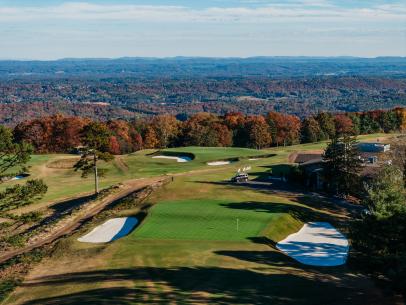 Private Lookout Mountain Club Lookout Mountain, GA 4.5 59 Panelists
Private Lookout Mountain Club Lookout Mountain, GA 4.5 59 Panelists
- Best In State
For decades, Lookout Mountain Club was viewed by architecture buffs and historians as one of the country’s great renovation opportunities. Seth Raynor laid out the course in 1925 on a high, tilting property near Lookout Mountain’s northeastern flank, just outside of Chattanooga. Raynor, who came into the profession over a decade earlier as a surveyor and construction specialist helping celebrated architect C.B. Macdonald build courses like National Golf Links of America, Piping Rock and the extinct Lido Club, had by this time become one of the most active and sought-after designers in the United States. At each of his commissions, including Lookout Mountain, he used variations of the “ideal holes” Macdonald first developed at NGLA (based on original holes from the U.K.), including the Redan, Eden, Road Hole, Alps, etc. These Raynor/Macdonald hole templates have always been present at Lookout Mountain, though few golfers would have recognized them. The course was never finished to Raynor’s plans or standards because he died in 1926 before construction began, and budget constraints and the difficulty of building on the mountain’s solid granite prevented his associate Charles Banks from executing the details. At the time, it was believed to be the second-most expensive golf course ever built, after Yale, another Raynor/Macdonald design. The subsequent years were no kinder. The club never had the resources to properly invest in preserving the Raynor architecture that did get built, and over the decades the greens shrunk, the bunkers dulled and tree-planting crowded the holes. Despite the memorable elevated setting, Lookout Mountain resembled a Raynor course only in glancing angles, a great “what if” considering that the architect’s best-preserved work includes four courses—Fishers Island, Chicago Golf Club, Camargo and Shoreacres—in Golf Digest’s top 50. Fortunes changed in 2022 when the club at last garnered the resources to produce the course Raynor envisioned. Working hole by hole, architects Tyler Rae and Kyle Franz, with significant help from designer Benjamin Warren, used the club’s course map that Raynor had drawn to fully implement the template holes in ways that better match the enormous scale of a site possessing views that stretch dozens of miles in several directions. All greens were cored out and rebuilt and the bunkers were either returned to intended positions or reproduce in accordance with the course map. Since the map sketches lacked specific detail, especially concerning green contours, Rae and Franz used their extensive experience working on and researching other Raynor courses to draw inspiration for certain holes. Many, like the Redan 13th, Road 15th, the Double Plateau 17th or Maiden 18th would be fits at many Raynor properties while others like the Sahara third, Dustpan fifth and Lido 14th must be considered originals, expressively so. But it all adds up for a thrilling expression of Macdonald/Raynor architecture on one of the most unique, breathtaking sites Raynor ever worked. The result of Rae and Franz’s restorative efforts won Lookout Mountain Golf Digest’s Best Renovation award for 2023. Explore our full review
RUNNERS-UP:
(1) Indian Creek C.C., Fla. Andrew Green (of a William Flynn design)
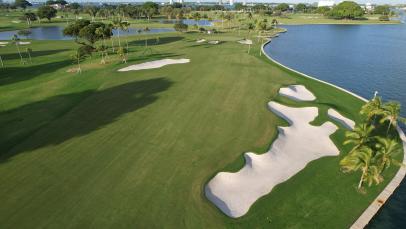 Private Indian Creek Country Club Indian Creek Village, FL 4.5 62 Panelists
Private Indian Creek Country Club Indian Creek Village, FL 4.5 62 Panelists
- Best In State
Indian Creek was built in 1930 on an island north of Miami Beach created with sand dredged from Biscayne Bay. William Flynn designed the course at the center of the island with estate homes ringing the perimeter along the water–the massive Mediterranean-style clubhouse opens toward a heroic, unimpeded southern view of downtown Miami. Over the decades drainage issues arose, and a renovation by Flynn’s former associate Dick Wilson along with other incremental tinkering had taken the shine off the original architecture. A 2022 rebuild by Andrew Green corrected the drainage problems leaving a dry and racy design with fairways that rise into elevated greens and banks left and right around bunkers that more closely resemble what Flynn originally designed. The standout hole has always been the long par-3 12th playing from a high tee over a cove of water and field of bunkers, but the short par 4s at four and 13 that also play along and inlet of Biscayne Bay called Indian Creek Lake are just as scenic and more thought-provoking. The par 5s at nine and 11 are also worthy of accolades, each gliding into greens situated on panoramic high points. Green’s reconstruction of Indian Creeek earned second place in the Golf Digest 2023 Best Renovation awards. View Course
(2) The Country Club, Cleveland. Gil Hanse and Jim Wagner (William Flynn)
 Private The Country Club Pepper Pike, OH 4.5 66 Panelists
Private The Country Club Pepper Pike, OH 4.5 66 Panelists
- Best In State
Located in the historically upscale Pepper Pike section of east Cleveland, The Country Club boasts a topography that is ideal for golf with smooth elevation changes peppered with moments of abruptly shifting land that William Flynn worked into the design when he built the course in the late 1920s. Standouts include the short, uphill par-4 third with bunkers stepped up the right side and the gorgeous, long downhill eighth, but the really good stuff is on the north side of the property. The green at the par-3 11th sits atop a skyline ridge that drops off steeply on the left. Second shots at the par-4 15th must fly uphill over a ridge and phalanx of diagonal bunkers to a blind green. The par-5 16th crests over a high shoulder before trundlng downhill to a heavily bunkered green, and the short par-4 17th bends sharply left around a kettle basin tempting long players to try to cut the corner. Already a star, “Country’s” stock is poised to rise further now that Gil Hanse and Jim Wagner have completed their 2022 renovation of the course that included enlarging bunkers to match the scale and topography of the property, expanding green perimeters and fairways, lowering tees, grassing the course and extending the 18th green by approximately 80 yards. View Course
(3) Wampanoag C.C., West Hartford, Conn. Tyler Rae and Kyle Franz, with Brad Klein (Donald Ross)
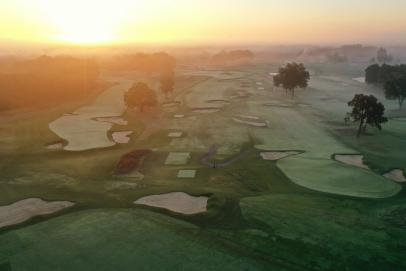 Private Wampanoag Country Club West Hartford, CT 4.1 8 Panelists Wampanoag has always possessed a gracefully gliding property in the now wooded suburbs of West Hartford, but it had long ago lost the finer points of its 1926 Donald Ross design. Modifications through the decades, including a poorly-received renovation in the 1980s that added the era’s popular mounds and moguls, pushed the design increasingly out of time and place. In 2022, architects Tyler Rae and Kyle Franz, working with historian-consultant Brad Klein (a former Wampanoag member), commenced a comprehensive restoration of the course that included several new and newly enlarged greens and tees and significant tree removal. Back are Ross’s cops and chiseled bunkers rotated at angles into the avenues of play setting up set-piece strategies. Rae and Franz restored lost bunkers and doubled their overall square footage, twisting them suggestively across fairways as Ross had them, and also re-introduced short top-shot bunkers that rarely come into play but create depth and directional confusion. Wampanoag finished fourth in the 2023 Best Renovation awards (out of 30 courses), and after nearly 100 years feels once again like the golf course it was meant to be. View Course
Private Wampanoag Country Club West Hartford, CT 4.1 8 Panelists Wampanoag has always possessed a gracefully gliding property in the now wooded suburbs of West Hartford, but it had long ago lost the finer points of its 1926 Donald Ross design. Modifications through the decades, including a poorly-received renovation in the 1980s that added the era’s popular mounds and moguls, pushed the design increasingly out of time and place. In 2022, architects Tyler Rae and Kyle Franz, working with historian-consultant Brad Klein (a former Wampanoag member), commenced a comprehensive restoration of the course that included several new and newly enlarged greens and tees and significant tree removal. Back are Ross’s cops and chiseled bunkers rotated at angles into the avenues of play setting up set-piece strategies. Rae and Franz restored lost bunkers and doubled their overall square footage, twisting them suggestively across fairways as Ross had them, and also re-introduced short top-shot bunkers that rarely come into play but create depth and directional confusion. Wampanoag finished fourth in the 2023 Best Renovation awards (out of 30 courses), and after nearly 100 years feels once again like the golf course it was meant to be. View Course
(4) Maketewah C.C., Cincinnati. Brian Silva (Donald Ross)
 Private Maketewah Country Club Cincinnati, OH Maketewah has developed a reputation as one of Cincinnati’s best player-clubs, boasting a membership of some of the best amateur golfers in Ohio. The course is also remarkable for the heavily jiggered topography. The clubhouse, ninth and 18th greens reside on an elevation at the center of the course, falling down into valleys that crisscross the property at different angles. Original architect Tom Bendelow’s 1910 routing is inspired in the way it traverses and plunges over the through the ravines toward high greens, and a 1929 Donald Ross renovation brought the bunkering and short game concepts into strategic focus. Even though Maketewah had been altered over the decades, it had never been considered one of Ross’s major works. That assessment must be reconsidered following Brian Silva’s 2022 remodel that reestablished the need for tactical play through the introduction of gorgeous Golden Age-style bunkers that cut into fairways and flank greens. The bunkering add to the visual charm of standout holes like the long fifth, uphill par 4 16th and the trap-door fairway 17th. Silva also moved the location of the 10th green and restyled the 11th into a short par 4 with posing different lines of attack, including the option of going for the peekaboo green tucked behind bunkers and a kicker mound. View Course
Private Maketewah Country Club Cincinnati, OH Maketewah has developed a reputation as one of Cincinnati’s best player-clubs, boasting a membership of some of the best amateur golfers in Ohio. The course is also remarkable for the heavily jiggered topography. The clubhouse, ninth and 18th greens reside on an elevation at the center of the course, falling down into valleys that crisscross the property at different angles. Original architect Tom Bendelow’s 1910 routing is inspired in the way it traverses and plunges over the through the ravines toward high greens, and a 1929 Donald Ross renovation brought the bunkering and short game concepts into strategic focus. Even though Maketewah had been altered over the decades, it had never been considered one of Ross’s major works. That assessment must be reconsidered following Brian Silva’s 2022 remodel that reestablished the need for tactical play through the introduction of gorgeous Golden Age-style bunkers that cut into fairways and flank greens. The bunkering add to the visual charm of standout holes like the long fifth, uphill par 4 16th and the trap-door fairway 17th. Silva also moved the location of the 10th green and restyled the 11th into a short par 4 with posing different lines of attack, including the option of going for the peekaboo green tucked behind bunkers and a kicker mound. View Course
(5) Conway Farms G.C., Lake Forest, Ill. David Kahn and Tim Jackson
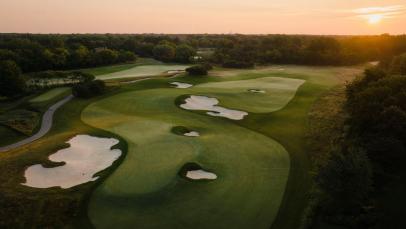 Private Conway Farms Golf Club Lake Forest, IL 4.4 89 Panelists
Private Conway Farms Golf Club Lake Forest, IL 4.4 89 Panelists
- Best In State
Conway Farms reopened in 2023 after substantial remodeling by Tim Jackson and David Kahn, who each worked under Tom Fazio on many of his western U.S. projects before joining together in 2009. The 1991 layout has been one of the premiere championship venues in the Chicago-area, having hosted multiple BMW Championships, NCAA national championships and other big-time amateur events. The remodel, conducted over 2021 and 2022, included the overhaul of the irrigation system, removal of trees and the rebuilding of multiple green complexes as well as a creek that comes into play on several holes. Significantly, Jackson and Kahn reoriented the course’s bunkering strategies, adjusting their sizes and locations, adding new ones where needed and upgrading their appearance to a more modern aesthetic. The essential qualities of the holes haven’t changed—par 4s like the fourth with a cross-hazard drive, the long 10th and the par-5 18th with a creek slicing into the green’s front are still beasts—but some of the shorter holes like the first, now bisected with a ravine short of the green that’s been shifted to the right, the drivable seventh presenting more options to place tee shots, and the lakeside 15th with a 75-yard deep serpentine green running along the water, are much more interesting. View Course More From Golf Digest+ 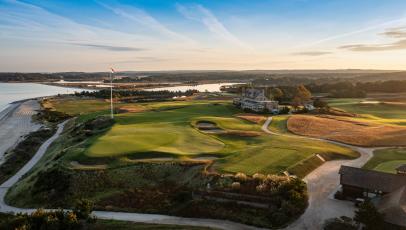 New Ranking America’s 100 Greatest Golf Courses
New Ranking America’s 100 Greatest Golf Courses %20hero.jpg.rend.hgtvcom.406.203.suffix/1620136440329.jpeg) Course Rankings The Best Golf Courses in Every State
Course Rankings The Best Golf Courses in Every State  Course Rankings World’s 100 Greatest Golf Courses BEST TRANSFORMATION
Course Rankings World’s 100 Greatest Golf Courses BEST TRANSFORMATION 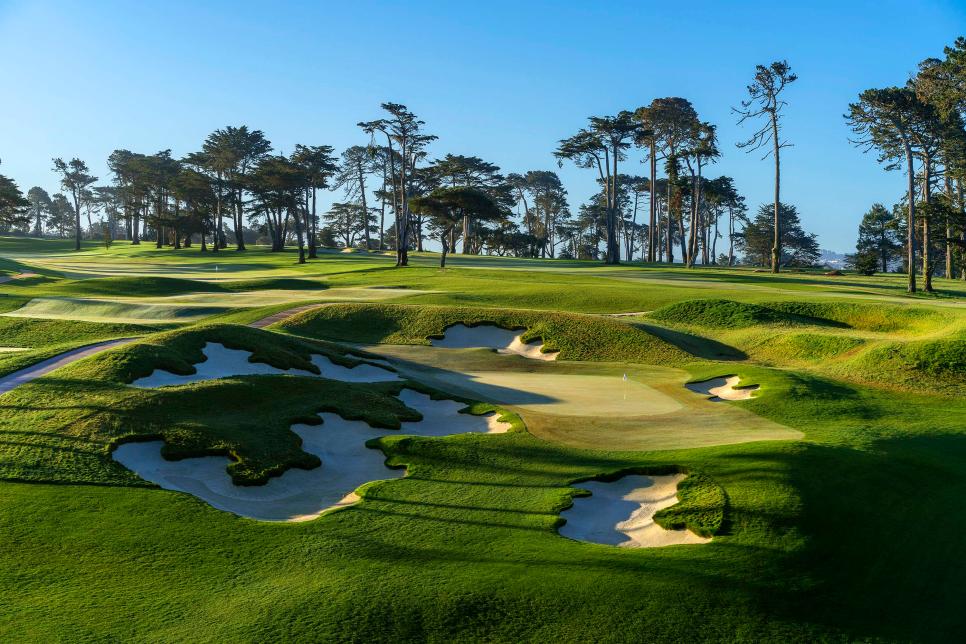
RESURRECTED: Lake Merced’s long lost par-3 17th hole was reborn as its new 13th.
Lake Merced Golf Club, Daly City, Calif.
6,915 yards, par 72
Gil Hanse and Jim Wagner
To understand why Hanse and Wagner’s work at Lake Merced was so profound, it’s necessary to understand the course’s complicated history. Lake Merced was founded in 1922 about eight miles south of San Francisco on farmland near the eponymous lake. The first iteration of the course, completed in 1923 by Scottish professional Willie Locke (a year ahead of neighbors Olympic Club and San Francisco Golf Club), was famously punishing with more than 350 bunkers. In 1928 Alister MacKenzie and Robert Hunter were hired to make modifications, namely to re-bunker the course and make it play more strategically.
The MacKenzie/Hunter course existed until the mid-1960s when the construction of Interstate 280 ate into 12 acres along its eastern boundary, forcing San Francisco-based architect Robert Muir Graves to reroute the course and add several new holes on an annexed parcel to the north. Rees Jones retained this configuration during a major 1990s remodel of new greens and bunkers that sat higher above the grade of the land.
Initially brought on for a traditional renovation, Hanse suggested the club consider returning the course to the MacKenzie version. The problem was that I-280 had eliminated a swath of land, and the mature pines and cypress planted in the 1920s now cloaked fairways and clogged old avenues. Reestablishing the MacKenzie routing would require the relocation of the modest driving range that Graves added near the sunken center of the property, with an unsightly net protecting golfers on the 10th hole.
“It became a jigsaw puzzle,” Hanse says. “How do you get all of that back?”
The first step was the removal of hundreds of trees to make space, mostly pines, before the property was stripped down to its base. Hanse and Wagner eliminated Graves’ holes four and five in the gully on the north side of the site and built a new, larger driving range there, now one of the better facilities in the city. That allowed them to reestablish the par-4 sixth hole and par-3 seventh in the old driving range basin where MacKenzie’s seventh and eighth holes had been, and their new par-3 third hole emulates the original, short par-3 fourth. All said, Hanse and Wagner were able to resurrect 14½ MacKenzie holes.
The northwest corner of the course experienced the most significant alterations, including the rebuilt par-4 12th and the reconstruction of one of Lake Merced’s most flamboyant holes, the downhill par-3 13th (it was MacKenzie’s 17th) with a green benched into a hillside surrounded by cloudlike bunkers. The par-3 16th, playing parallel to the 13th in the opposite direction, is an original hole that Hanse created to compensate for the loss of the old first hole with a wide, shallow green that moves balls toward left hole locations.
For all their experience renovating many of the country’s historic courses, Lake Merced is the first Alister MacKenzie course Hanse and Wagner have worked on. Getting the distinct look of the MacKenzie/Hunter northern California bunkering took some practice.
“A lot of MacKenzie’s bunkers laid almost at grade,” Hanse says. “They were in the ground and didn’t have the big, pronounced upsweep we’re more familiar with, so we had to relearn how to shape and build them. There was a lot of head scratching and kicking the dirt, but it was fun, and the golf course really breathes and fits beautifully on that landscape now. It feels right.”
 Private Lake Merced Golf Club Daly City, CA 4.1 85 Panelists
Private Lake Merced Golf Club Daly City, CA 4.1 85 Panelists
- Best In State
Lake Merced is one of the latest clubs to benefit from the restoration work of Gil Hanse, Jim Wagner and their team. In 1962 a freeway forced a major overhaul of the work Alister Mackenzie did in 1929 and 1930, changing the look and feel of the golf course. Gone were the deep barrancas, sandy waste areas and Mackenzie’s signature mounding and bunker designs. Hanse recaptured these lost features using what he often does—expansive research using historical photos and aerials. All 18 green and tee complexes were rebuilt, but perhaps most dramatically, 150,000 square feet of bunkers were refurbished to match Mackenzie’s signature style. What has emerged is a revitalization of one of California’s great courses that will further both Hanse’s and Mackenzie’s legacy as two of the most important architects in the game. View Course
RUNNERS-UP:
(1) Atlanta Athletic Club Riverside Course, Johns Creek, Ga. Tripp Davis
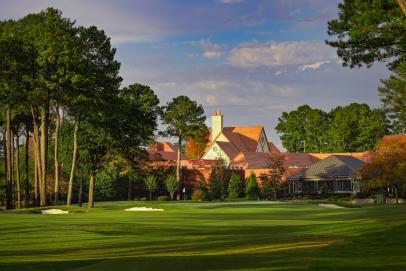 Private Atlanta Athletic Club: Riverside Johns Creek, GA 4.1 76 Panelists
Private Atlanta Athletic Club: Riverside Johns Creek, GA 4.1 76 Panelists
- Best In State
Robert Trent Jones built 27 holes for Atlanta Athletic Club when it moved from East Lake in Atlanta to the northern suburb of Duluth (now Johns Creek) in the late 1960s. When Joe Finger added another nine on a high section of the property in the early 70s, the holes were regrouped as the Highlands Course, host of the 1976 U.S. Open and 2001 and 2011 PGA Championships, and the Riverside Course. Riverside was always viewed as the more friendly, non-championship course, though it hosted it’s share of prestigious tournaments as well. Rees Jones did major work on both courses through the years and the style of each came to resemble more his architeture than his father’s. In 2022, Tripp Davis remodeled Riverside, rebuilding and reshaping each hole, green site and bunkers to tie them better into the landforms, creating new looks and several new holes in the process. Davis divided the par-5 third into a short par 3 and a par 4 with the new green pushed back against the Chattahoochee River, then combined the old fourth and fifth into a par 5 that bends gradually right. The twelfth green was pushed back 80 yards to turn it into a par 5, the par-3 17th green was rebuilt with modifeid punchbowl shaping and water hazards near the greens at 14 and 18 were removed. Riverside finished second for the 2023 Best Transformation award. View Course
(2) Richland C.C., Nashville. Bill Bergin
 Private Richland Country Club Nashville, TN 4 28 Panelists
Private Richland Country Club Nashville, TN 4 28 Panelists
- Best In State
Richland Country Club was chartered as the Nashville Golf Club 1901, though it has moved locations several times and played a handful of different golf courses, including one laid out by Donald Ross in 1921. In 1988 the club moved to a new site in the hill country south of the city and hired Jack Nicklaus to design it course up to the modern standards of the day. Atlanta based architect Bill Bergin conducted a significant transformation of that design in 2021 that focused on expanding greens and fairways, removing excess trees and rebuilding (fewer) grass-faced bunkers notched into upslopes as Ross might have on this site. Significantly, the two nines were flipped and the first and ninth holes (formerly 10 and 18) have been directionally reversed for better flow. Richland placed third in the 2023 Best Transformation awards. View Course
(3) Belleair C.C. West Course, Fla. Dana Fry and Jason Straka
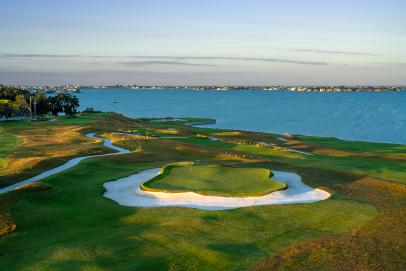 Private Belleair Country Club: West Belleair, FL 4.2 11 Panelists The history of Belleair in the resort community of the same name, 25 miles west of Tampa on the Gulf of Mexico, mirrors that of many historic clubs that trace their ancestry to the turn of the last century. Its first rudimentary holes were laid down by amateurs in the waning years of the 19th century and then gradually added onto over the next decade, crudely, before an expert was brought in to straighten everything out. In this case, Donald Ross, who revamped the by-then 18 and added another course to the east. Ross returned in the 1920s to take second turn at revisions based on another decade of experience designing courses across the U.S. Others visited through the years to put their own tweaks on the West Course, and by 2020 Belleair had little distinguishing pedigree. The club hired Jason Straka and Dana Fry to revamp the course using original Ross sketches to rebuild the holes. While the architects, Straka in particular, adhered to the historic source material as closely as possible, it’s more accurate to describe Belleair as a new course built in the style of the old. Large portions of the site were re-graded and several large irrigation ponds were filled. The majority of trees were removed to enhance views out to Clearwater Harbor, and the rugged streams that once laced through the course were reconstructed. The first three holes were re-routed and a new par-3 seventh was added with a green on a peninsula jutting into the bay. To accommodate the extra hole, the old par-3 12th was eliminated leaving space for what are now the 10th, 11th and 12th to be extended to the east. Among the radical changes, views and provocative bunkering, the most impressive move might be the subtle shifting of the sixth fairway to the right so it runs hard against the length of the seawall, creating a straight-line and frightening strategic hazard. View Course
Private Belleair Country Club: West Belleair, FL 4.2 11 Panelists The history of Belleair in the resort community of the same name, 25 miles west of Tampa on the Gulf of Mexico, mirrors that of many historic clubs that trace their ancestry to the turn of the last century. Its first rudimentary holes were laid down by amateurs in the waning years of the 19th century and then gradually added onto over the next decade, crudely, before an expert was brought in to straighten everything out. In this case, Donald Ross, who revamped the by-then 18 and added another course to the east. Ross returned in the 1920s to take second turn at revisions based on another decade of experience designing courses across the U.S. Others visited through the years to put their own tweaks on the West Course, and by 2020 Belleair had little distinguishing pedigree. The club hired Jason Straka and Dana Fry to revamp the course using original Ross sketches to rebuild the holes. While the architects, Straka in particular, adhered to the historic source material as closely as possible, it’s more accurate to describe Belleair as a new course built in the style of the old. Large portions of the site were re-graded and several large irrigation ponds were filled. The majority of trees were removed to enhance views out to Clearwater Harbor, and the rugged streams that once laced through the course were reconstructed. The first three holes were re-routed and a new par-3 seventh was added with a green on a peninsula jutting into the bay. To accommodate the extra hole, the old par-3 12th was eliminated leaving space for what are now the 10th, 11th and 12th to be extended to the east. Among the radical changes, views and provocative bunkering, the most impressive move might be the subtle shifting of the sixth fairway to the right so it runs hard against the length of the seawall, creating a straight-line and frightening strategic hazard. View Course
(4) Metairie C.C., La. Brian Silva
 Private Metairie Country Club Metairie, LA 3.9 42 Panelists
Private Metairie Country Club Metairie, LA 3.9 42 Panelists
- Best In State
Metairie Country Club, opened in 1925, was the jewel of New Orleans golf through the first decade of its existence. It was designed by Seth Raynor and possessed variations of his much-studied template holes originally introduced by his mentor, C.B. Macdonald at National Golf Links of America and other courses. A land swap in 1928 fundamentally altered the second nine routing of holes 14-18, and hard economic conditions and infrastructure challenges in the late 1930s prompted further renovations that compromised Raynor’s design, a trend that continued for decades. The club never retained Raynor’s blueprints for the course and were not sure precisely what the archtiect had left behind, so in 2021 they hired Brian Silva to reimagine a pure Raynor course on the property. Drawing on as much experience studying and reviving Raynor’s designs throughout the country as anyone over the last 30 years, Silva reproduced vivid versions of the Bottle, Biarritz, Redan, Leven, Road, Eden and others. Though not a historical restoration, Metairie has been completely and imaginitively transformed. View Course
(5) Broken Sound Club Old Course, Boca Raton, Fla. Rees Jones and Bryce Swanson
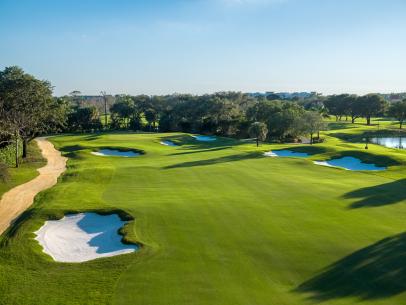 Private Broken Sound Club: Old Course Boca Raton, FL 4.1 10 Panelists Broken Sound Club’s Old Course is one of the best courses in Boca Raton, Florida. Discover our experts reviews here View Course Macdonald-Raynor Holes Explained
Private Broken Sound Club: Old Course Boca Raton, FL 4.1 10 Panelists Broken Sound Club’s Old Course is one of the best courses in Boca Raton, Florida. Discover our experts reviews here View Course Macdonald-Raynor Holes Explained
Alps: A hole with a blind approach over a hill to a punchbowl green fronted with bunkers.
Biarritz: A long par 3 with a deep green featuring high sections separated by a low trough in the center.
Cape: A hole with a green cocked at an angle over bunkers or water, often coupled with a diagonal risk-reward tee shot. Channel: A par 5 with a separate island fairway shortcut separated from the primary fairway by water or sand.
Dog’s Leg: A Lido original referencing a Seth Raynorinspired par 5 that sweeps right around bunkers.
Eden: A par 3 modeled after the 11th at St. Andrews with a wide green sloping back to front above two deep bunkers.
Maiden: The reference to a par 3 at Royal St. George’s now denotes a green with two elevated back mounds divided by a swale.
Home: Original to The Lido, a broad par 4 with multiple avenues of play based on a design by Alister MacKenzie.
Long: A par 5 modeled after the 14th at St. Andrews with a version of the Hell Bunker, which is a formidable carry in the fairway.
Plateau: Short for Double Plateau, a green with three distinct levels, often arranged in different configurations.
Principal’s Nose: An elevated configuration of three bunkers that can resemble a nose and pair of eyes; used at Lookout Mountain to separate left and right fairway paths.
Punchbowl: A green surrounded with high banks that collect shots onto the putting surface.
Redan: A par 3 with an angled green sloping front to back and outside edge to inside edge.
Road: A par 4 or 5 modeled after the 17th at St. Andrews with a deep pot bunker protecting the green and another long bunker or depression behind it.
Sahara: A short par 4 requiring a tee shot across an often-blind hazard to reach the green or set up a clear angle approach.
This article was originally published on golfdigest.com



